Circularly Polarized Reconfigurable MIMO Antenna for WLAN Applications
Abstract
1. Introduction
2. Design of MIMO Element
2.1. Passive Antenna
2.2. Polarization Reconfigurable Antenna
3. Design of Polarization Reconfigurable MIMO Antenna
3.1. MIMO Configuration
3.2. Operating Performance
4. MIMO Diversity Performance

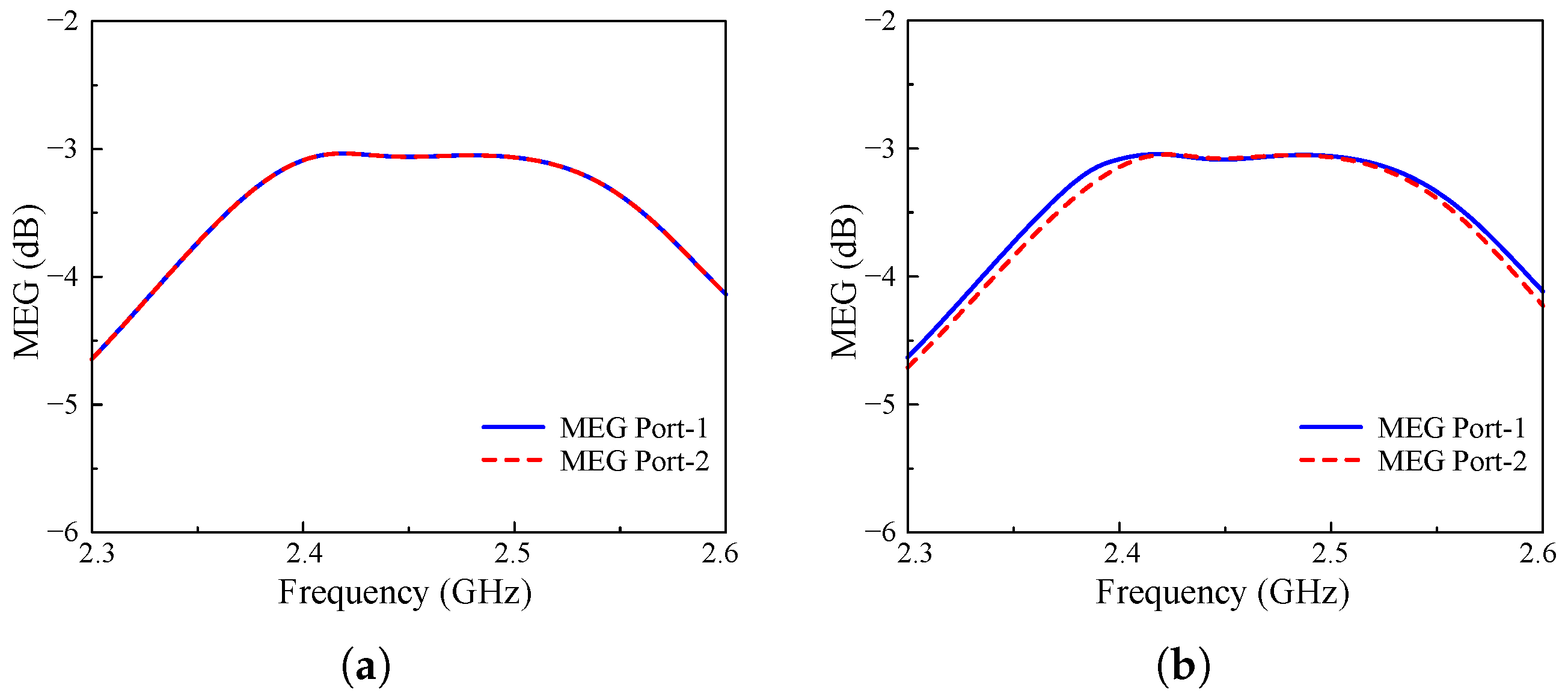
5. Measurement Results
6. Comparison
7. Conclusions
Author Contributions
Funding
Institutional Review Board Statement
Informed Consent Statement
Data Availability Statement
Conflicts of Interest
References
- Oh, P.S.; Kwon, S.S.; Molisch, A.F. Antenna Selection in Polarization Reconfigurable MIMO (PR-MIMO) Communication Systems. arXiv 2021, arXiv:2112.00931. [Google Scholar]
- Lin, W.; Wong, H. Wideband Circular Polarization Reconfigurable Antenna. IEEE Trans. Antennas Propag. 2015, 63, 5938–5944. [Google Scholar] [CrossRef]
- Bhattacharjee, A.; Dwari, S.; Mandal, M.K. Polarization-Reconfigurable Compact Monopole Antenna with Wide Effective Bandwidth. IEEE Antennas Wirel. Propag. Lett. 2019, 18, 1041–1045. [Google Scholar] [CrossRef]
- Wu, F.; Luk, K.M. A Compact and Reconfigurable Circularly Polarized Complementary Antenna. IEEE Antennas Wirel. Propag. Lett. 2017, 16, 1188–1191. [Google Scholar] [CrossRef]
- Li, M.; Yang, Z.; Zhang, Z.; Tang, M.C.; Zhu, L. Miniaturized, Slow-Wave Transmission Line-Based Annular Ring Antenna With Reconfigurable Circular Polarization and High Gain. IEEE Antennas Wirel. Propag. Lett. 2023, 22, 1766–1770. [Google Scholar] [CrossRef]
- Yang, X.X.; Shao, B.C.; Yang, F.; Elsherbeni, A.Z.; Gong, B. A Polarization Reconfigurable Patch Antenna with Loop Slots on the Ground Plane. IEEE Antennas Wirel. Propag. Lett. 2012, 11, 69–72. [Google Scholar] [CrossRef]
- Wang, K.X.; Wong, H. A Reconfigurable CP/LP Antenna with Cross-Probe Feed. IEEE Antennas Wirel. Propag. Lett. 2017, 16, 669–672. [Google Scholar] [CrossRef]
- Han, L.; Ping, Y.; Liu, Y.; Han, G.; Zhang, W. A Low-Profile Pattern Reconfigurable MIMO Antenna. IEEE Access 2020, 8, 34500–34506. [Google Scholar] [CrossRef]
- Ahmad, S.; Khan, S.; Manzoor, B.; Soruri, M.; Alibakhshikenari, M.; Dalarsson, M.; Falcone, F. A Compact CPW-Fed Ultra-Wideband Multi-Input-Multi-Output (MIMO) Antenna for Wireless Communication Networks. IEEE Access 2022, 10, 25278–25289. [Google Scholar] [CrossRef]
- Padmanathan, S.; Abdullah Al-Hadi, A.; Elshirkasi, A.M.; Al-Bawri, S.S.; Islam, M.T.; Sabapathy, T.; Jusoh, M.; Akkaraekthalin, P.; Soh, P.J. Compact Multiband Reconfigurable MIMO Antenna for Sub- 6GHz 5G Mobile Terminal. IEEE Access 2022, 10, 60241–60252. [Google Scholar] [CrossRef]
- Zhao, X.; Riaz, S. A Dual-Band Frequency Reconfigurable MIMO Patch-Slot Antenna Based on Reconfigurable Microstrip Feedline. IEEE Access 2018, 6, 41450–41457. [Google Scholar] [CrossRef]
- Zhao, X.; Riaz, S.; Geng, S. A Reconfigurable MIMO/UWB MIMO Antenna for Cognitive Radio Applications. IEEE Access 2019, 7, 46739–46747. [Google Scholar] [CrossRef]
- Kumar, S.; Palaniswamy, S.K.; Choi, H.C.; Kim, K.W. Compact Dual Circularly-Polarized Quad-Element MIMO/Diversity Antenna for Sub-6 GHz Communication Systems. Sensors 2022, 22, 9827. [Google Scholar] [CrossRef] [PubMed]
- Hussain, N.; Aljaloud, K.; Hussain, R.; Alqahtani, A.H.; Khan, Z.U.; Tahir, F.A.; Abbasi, Q.H. Dual-sense slot-based CP MIMO antenna with polarization bandwidth reconfigurability. Sci. Rep. 2023, 13, 16132. [Google Scholar] [CrossRef]
- Li, Y.; Zhang, Z.; Zheng, J.; Feng, Z. Channel capacity study of polarization reconfigurable slot antenna for indoor MIMO system. Microw. Opt. Technol. Lett. 2011, 53, 1209–1213. [Google Scholar] [CrossRef]
- Kumar Jaiswal, R.; Kumar Dutta, R.; Das, G.; Kumar Ojha, A.; Sim, C.Y.D.; Vaibhav Srivastava, K. Circularly polarized three-element MIMO antenna with diversity and polarization reconfigurability techniques. AEU-Int. J. Electron. Commun. 2023, 162, 154566. [Google Scholar] [CrossRef]
- Thangarasu, D.; Palaniswamy, S.K.; Thipparaju, R.R. Quad port multipolarized reconfigurable MIMO antenna for sub 6 GHz applications. Int. J. Antennas Propag. 2023, 2023, 8882866. [Google Scholar] [CrossRef]
- Guo, J.; Ping, Y.; Zhao, Y.; Liu, Y.; Han, L. Design of a Full Polarization Reconfigurable MIMO Antenna. Prog. Electromagn. Res. Lett. 2023, 110, 73–81. [Google Scholar] [CrossRef]
- Dao-Duc, T.; Tran-Viet, D.N.; Nguyen Tien, D.; Nguyen Quoc, D.; The-Lam Nguyen, T.; Tran-Huy, H. A compact co-aperture dual-sense circularly polarized antenna for simultaneous transmit and receive systems. PLoS ONE 2024, 19, e0304414. [Google Scholar] [CrossRef] [PubMed]
- Available online: https://cdn.macom.com/datasheets/MADP-042XX5.pdf (accessed on 20 October 2024).


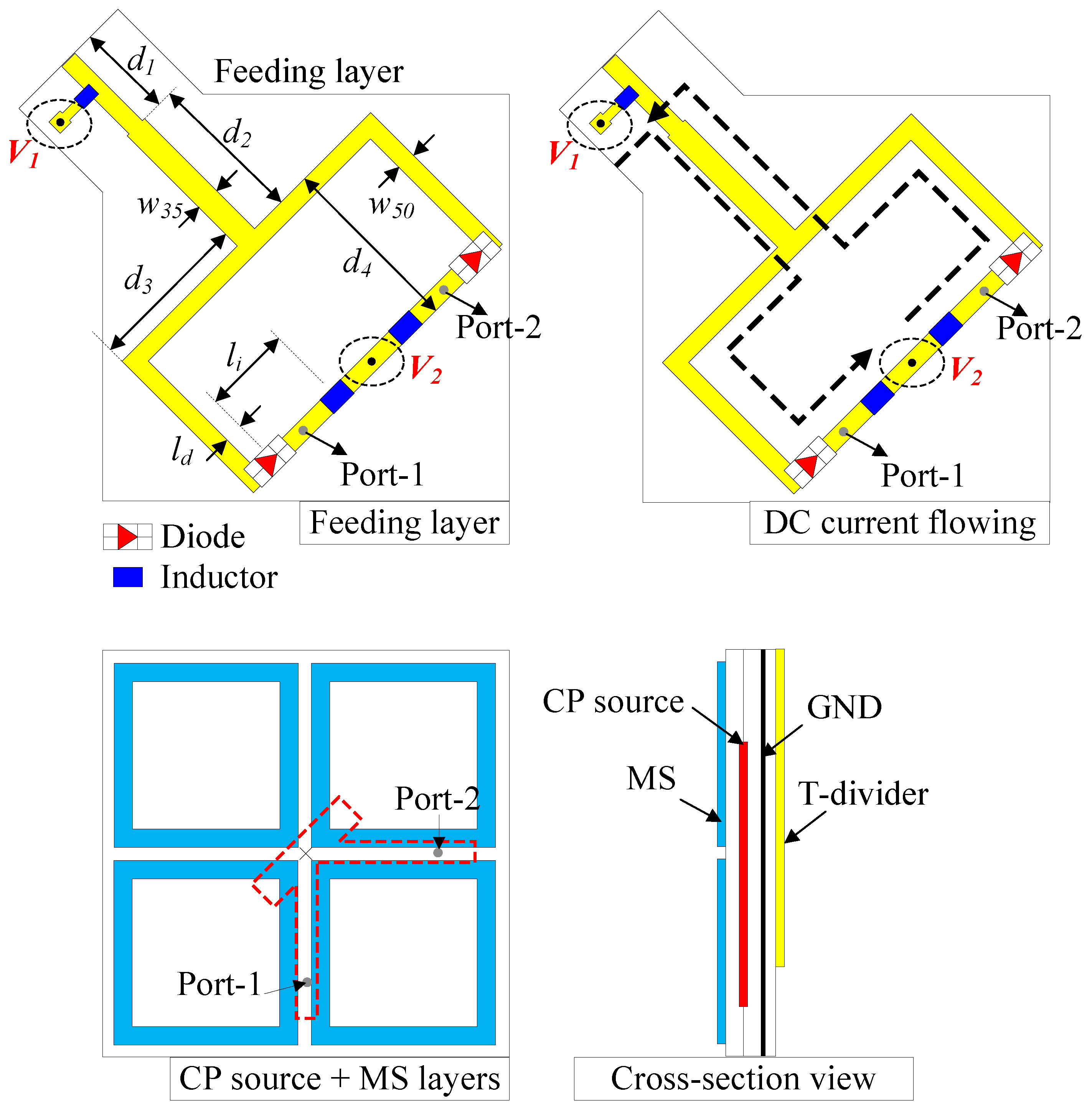
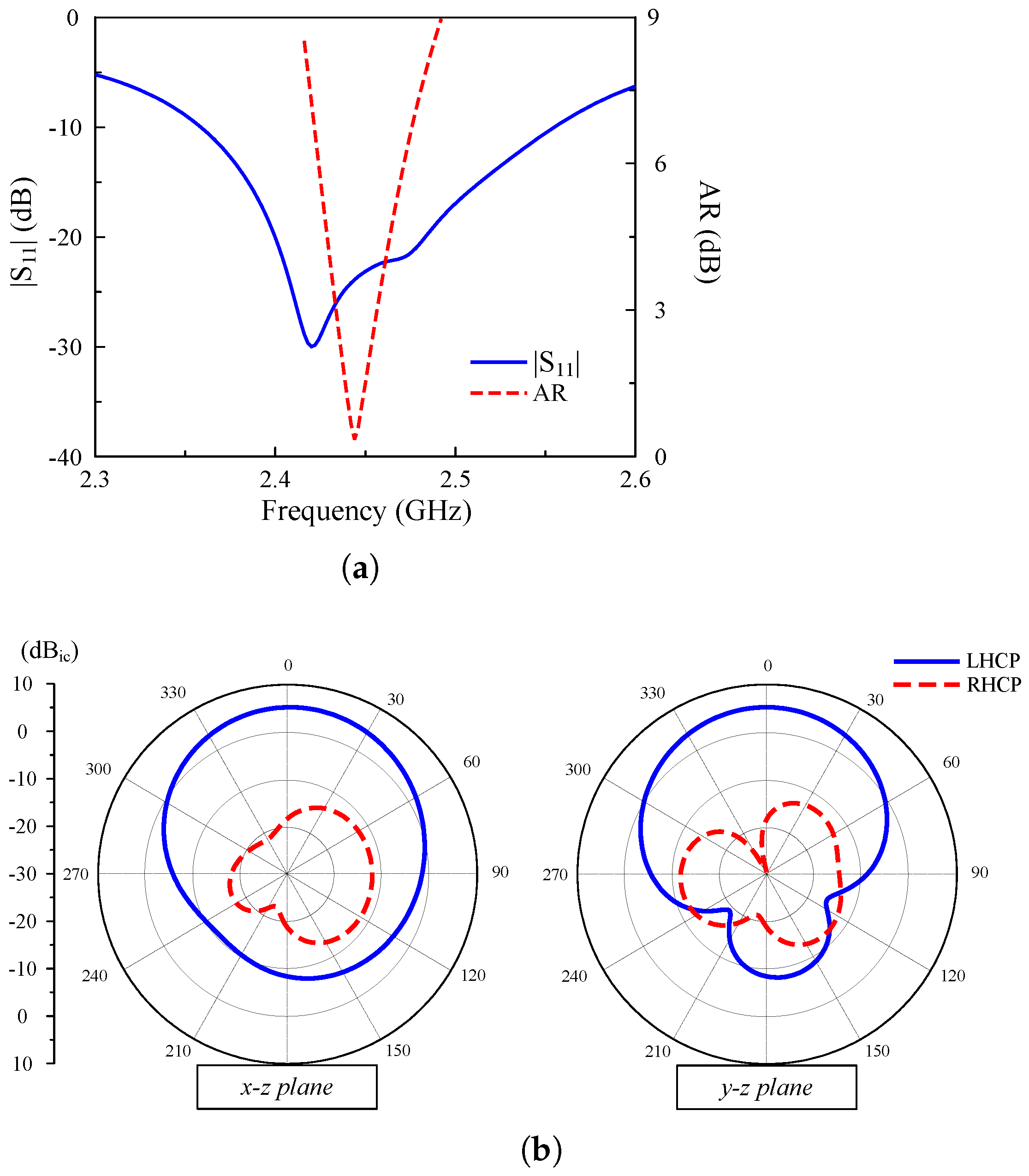
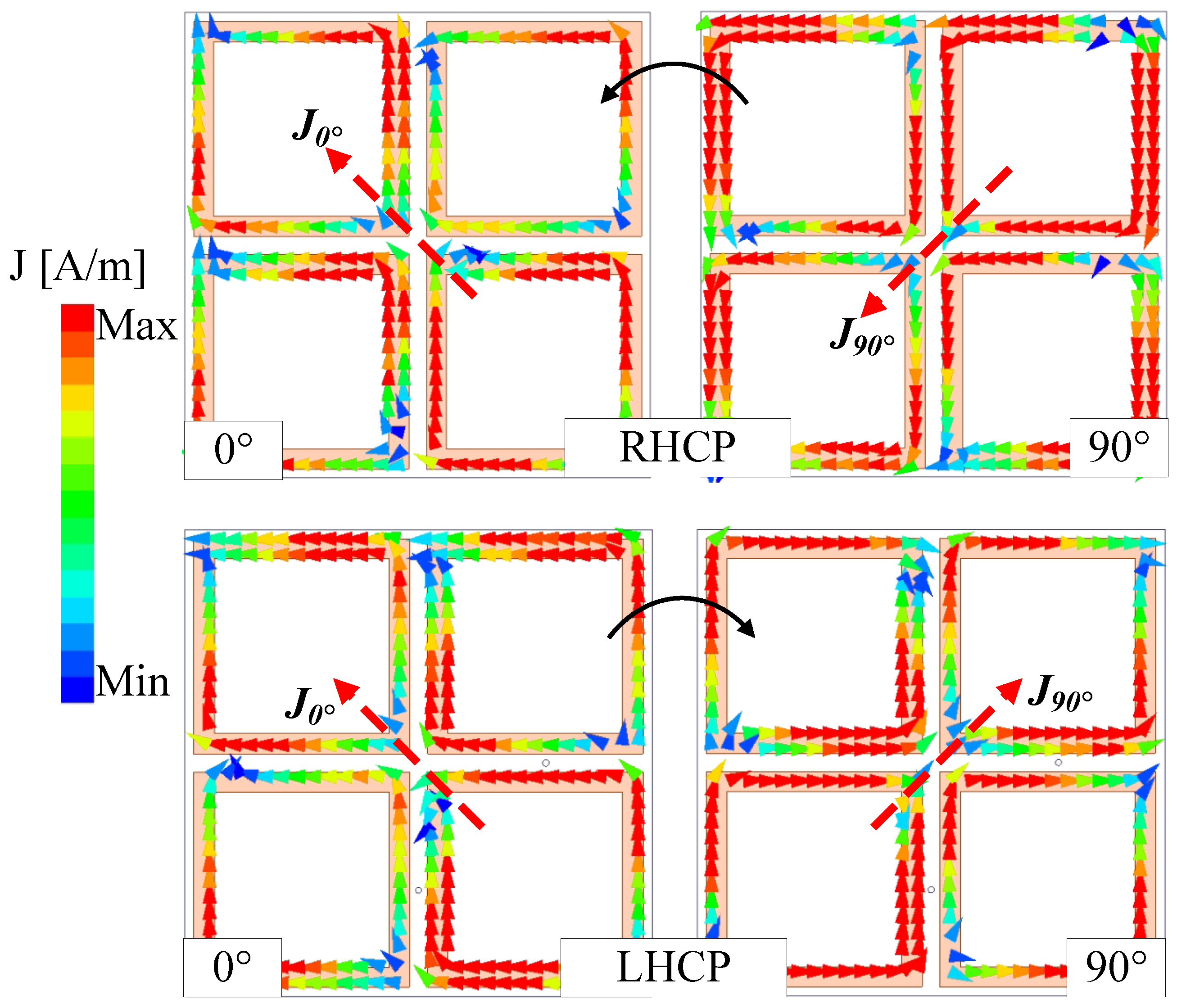

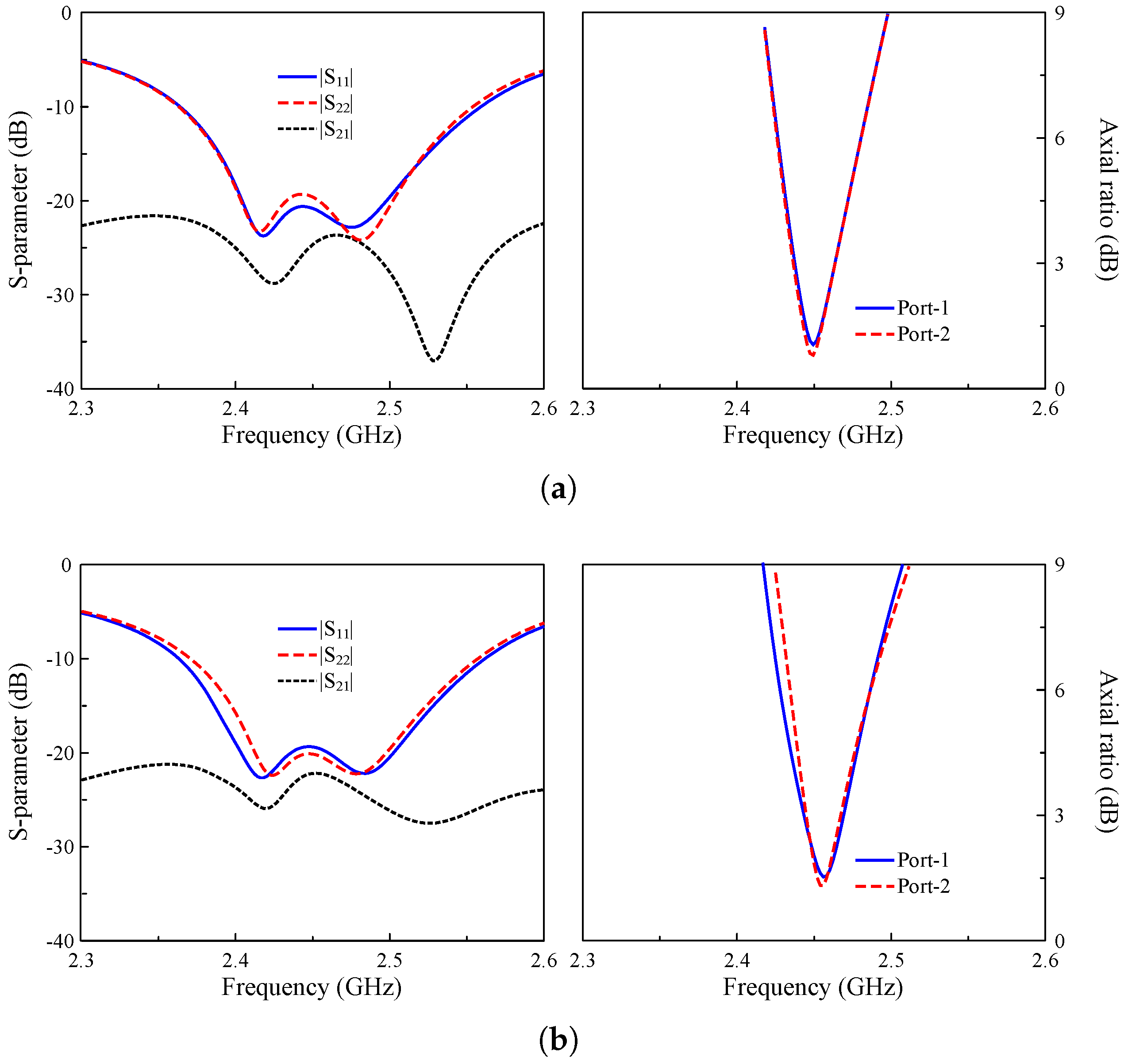


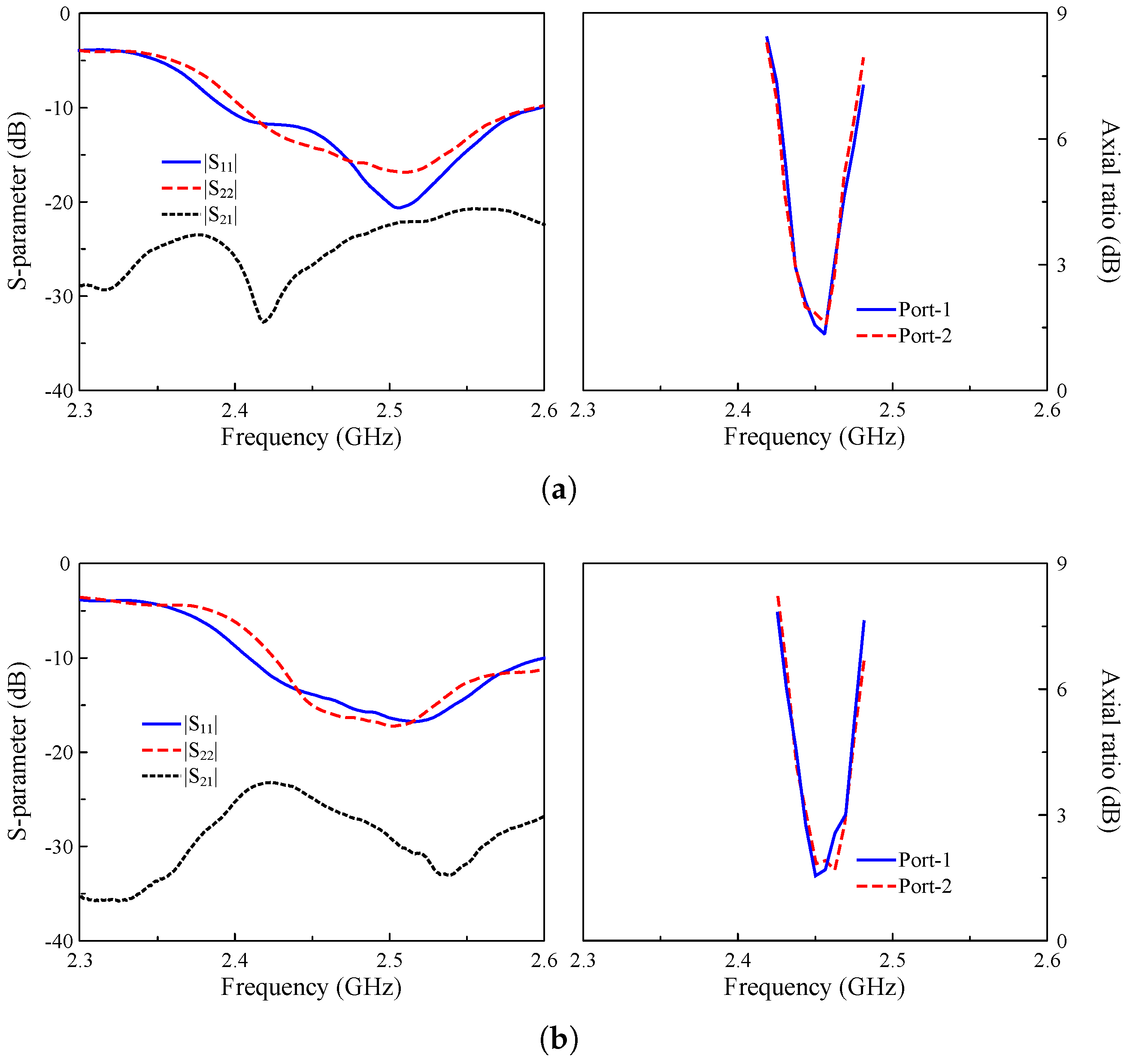
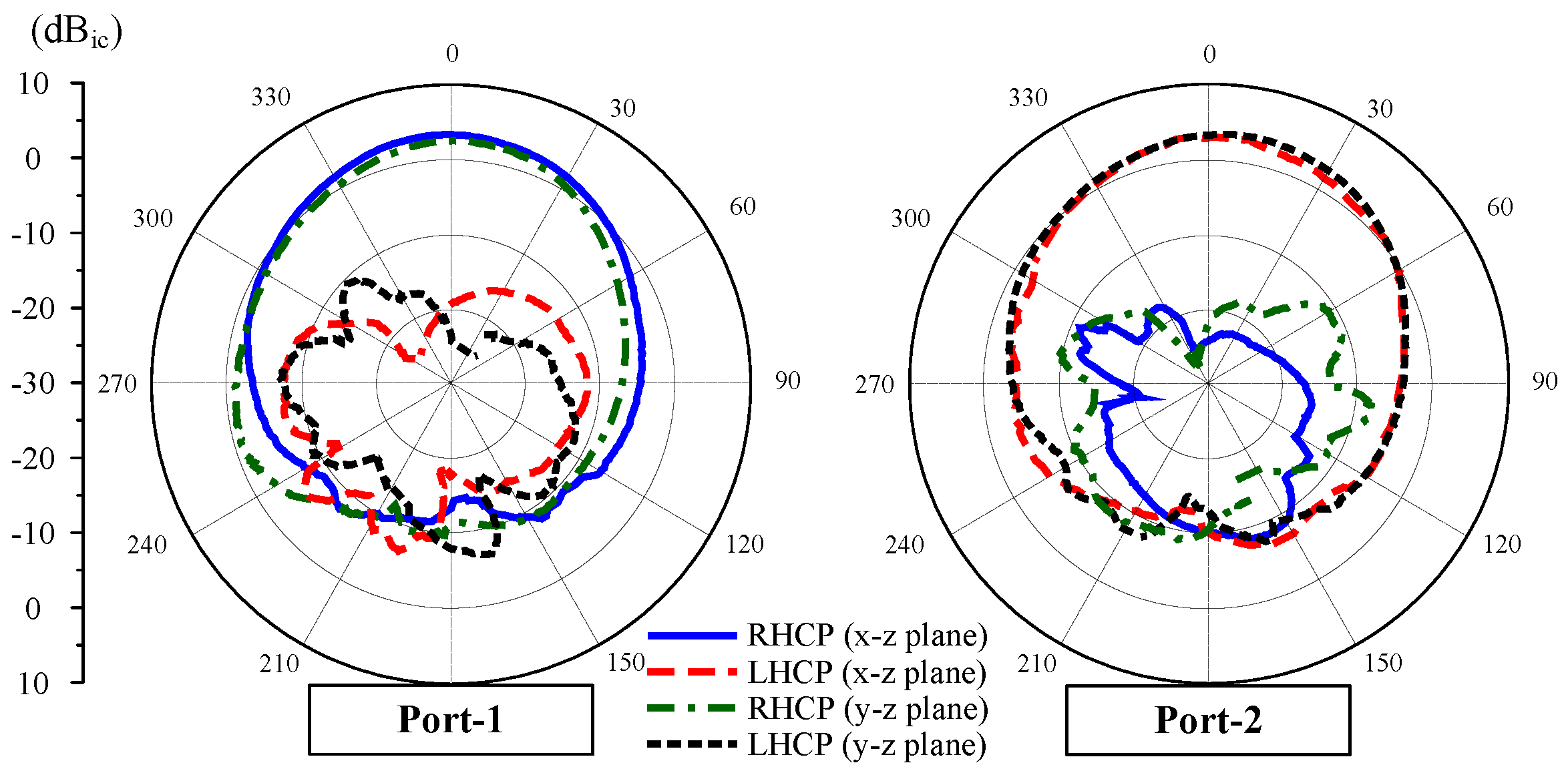
| Parameters | Ant-1 | Ant-2 | Parameters | Ant-1 | Ant-2 |
|---|---|---|---|---|---|
| P | 22 | 22 | G | 12.4 | 12 |
| W | 20 | 20.3 | 13.4 | 18 | |
| 13.2 | 12 | 4 | 1.2 | ||
| 3.8 | 3 | 1.52 | 1.52 | ||
| 1.52 | 1.52 |
| Operating Case | Diode States | Polarization State | ||||
|---|---|---|---|---|---|---|
| Port-1 | Port-2 | |||||
| Case-1 | ON | OFF | ON | OFF | RH-CP | LH-CP |
| Case-2 | ON | OFF | OFF | ON | RH-CP | RH-CP |
| Case-3 | OFF | ON | ON | OFF | LH-CP | LH-CP |
| Case-4 | OFF | ON | OFF | ON | LH-CP | RH-CP |
| Ref. | Antenna Size | Antenna Type | No. of Elements | No. of Diodes | Polarization | Max. Gain (dB) |
|---|---|---|---|---|---|---|
| [14] | 0.22 × 0.22 × 0.01 | Slot | 2 | 2 | RHCP, LHCP, LP | 1.1 |
| [15] | Not Given | Slot | 2 | 4 | V-LP, H-LP | 2.2 |
| [16] | 1.14 × 0.79 × 0.03 | Slot | 3 | 10 | RHCP, LHCP | 2.6 |
| [17] | 1.25 × 1.36 × 0.03 | Monopole | 4 | 4 | RHCP, LHCP, LP | 4.5 |
| [18] | 1.22 × 1.22 × 0.05 | Patch | 2 | 16 | RHCP, LHCP, LP | 5.8 |
| Prop. | 0.76 × 0.76 × 0.03 | MS | 2 | 4 | RHCP, LHCP | 4.3 |
Disclaimer/Publisher’s Note: The statements, opinions and data contained in all publications are solely those of the individual author(s) and contributor(s) and not of MDPI and/or the editor(s). MDPI and/or the editor(s) disclaim responsibility for any injury to people or property resulting from any ideas, methods, instructions or products referred to in the content. |
© 2025 by the authors. Licensee MDPI, Basel, Switzerland. This article is an open access article distributed under the terms and conditions of the Creative Commons Attribution (CC BY) license (https://creativecommons.org/licenses/by/4.0/).
Share and Cite
Le-Tuan, T.; Nguyen, T.D.; Tran, N.V.-D.; Tran, H.; Nguyen-Tien, D. Circularly Polarized Reconfigurable MIMO Antenna for WLAN Applications. Sensors 2025, 25, 1257. https://doi.org/10.3390/s25041257
Le-Tuan T, Nguyen TD, Tran NV-D, Tran H, Nguyen-Tien D. Circularly Polarized Reconfigurable MIMO Antenna for WLAN Applications. Sensors. 2025; 25(4):1257. https://doi.org/10.3390/s25041257
Chicago/Turabian StyleLe-Tuan, Tu, Thai Dinh Nguyen, Nguyen Viet-Duc Tran, Hung Tran, and Dat Nguyen-Tien. 2025. "Circularly Polarized Reconfigurable MIMO Antenna for WLAN Applications" Sensors 25, no. 4: 1257. https://doi.org/10.3390/s25041257
APA StyleLe-Tuan, T., Nguyen, T. D., Tran, N. V.-D., Tran, H., & Nguyen-Tien, D. (2025). Circularly Polarized Reconfigurable MIMO Antenna for WLAN Applications. Sensors, 25(4), 1257. https://doi.org/10.3390/s25041257





